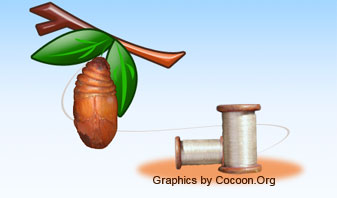How Silk is made from Cocoons
 Today the silk industry is worth a lot of money. It is actually worth anywhere between $200 and $500 million aeach year. This is because there is such great demand for items that are made from silk. Usually the species Bombyx mori is cultivated and raised under controlled conditions. There are various stages to this process. They include:
Today the silk industry is worth a lot of money. It is actually worth anywhere between $200 and $500 million aeach year. This is because there is such great demand for items that are made from silk. Usually the species Bombyx mori is cultivated and raised under controlled conditions. There are various stages to this process. They include:
• When the silk worm forms a covering around itself by secreting a protein through its head, this is called the cocoon stage. This is the most desirable stage for the silk producers. It is at this time that the cocoons are delivered to the factory by the farmer. These factories are called filature operations.
• Once the cocoons reach the filature operations they are sorted by color, size, shape and texture. They usually range from white and yellow to grayish.
• After the cocoons have been sorted, they have to be boiled in water, while they are still intact, for 5 minutes while they are being turned gently. They are then taken out of the water and a dissecting needle is used to start picking up the strands. Once a single strand is found that will come off easily it has to be wound around a pencil. This is how the cocoon is loosened so that it can be unwound in 1 continuous thread, which are collected into skeins. The process is called “reeling.”
• Since the thread is too fine for commercial use, between 3 and 10 strands then have to be reeled together to produce the desired diameter of raw silk. This is known as “reeled silk.” It will take 3,000 cocoons to make just 1 pound of this type of silk.
This silk must then be reeled into skeens and packed into small bundles called books. These are then shipped to silk mills around the world.
Bee Cocoons
What is a Cocoon
Cocoons in the winter time
How long Cocoon Last?
Silk Made From Cocoon
Silkworm Cocoon
Orgin of word Cocoon
The Surprises in Cocoons
Types of Insects in Cocoon
Butterfly or Moth Cocoon
Making of Cocoons
Ant – Cocoon Connection
From Cocoon to Adult: Role of Hormones
Cocoon that resembles a Bag
Cocoon Architecture
Mud Cocoons
Interesting Cocoons
Cocoon Food
Glochidium Cocoon
Sleeping Bag Cocoon
Cremaster, Nature’s Velcro
Frog Cocoon
Earthworm Cocoonv
Cocoon Rattles
Mites And Bee cocoon
Say No to Silk
Cocoon Inside Cocoon
Sensing From Inside Cocoon
Cocoon That Resembles Rabbit droppings
Hammock Shaped Cocoon
Chipwood Cocoon
Slime Cocoon
Cocoon For Eggs
